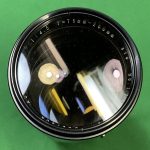Soligor Auto-Zoom 75-260mm F/4.5
Telephoto zoom lens • Film era • Discontinued
Specification
| Optical design: | |
| 35mm full frame | |
| 75mm - 260mm [3.5X zoom ratio] | |
| F/4.5 across the focal length range | |
| 13 elements in 10 groups | |
| Interchangeable mount (T-4) | |
| 32.2° @ 75mm - 9.5° @ 260mm (35mm full frame) | |
| Diaphragm mechanism: | |
Diaphragm type: | Automatic |
Aperture control: | Aperture ring (Manual settings only) |
| 8 (eight) | |
| Zooming: | |
Zoom mechanism: | Manual |
Zoom control: | Zoom ring |
Zoom type: | Rotary |
Zooming method: | Extends while zooming |
| Focusing: | |
| 1.80m | |
| <No data> | |
Focusing modes: | Manual focus only |
Manual focus control: | Focusing ring |
| Physical characteristics: | |
| 1080g | |
| ⌀75×185mm | |
| Accessories: | |
| Screw-type 67mm | |
| Built-in telescopic round | |
| <No data> |
Sources of data
- Manufacturer's technical data.
- Miranda Sensorex II instructions (in Japanese).
From the editor
The Miranda Sensorex-II instruction manual (in Japanese) indicates a slight longer closest focusing distance of 2m.
Notes
- Independent-brand lenses were made for 35mm film SLR cameras by companies that competed with the camera manufacturers. Some came from factories that made lenses under their own brand names (Angenieux, Kiron, Sigma, Tamron, Tokina). Many others were national and international marketing organizations (Kalimar, Panagor, Rokunar, Soligor, Starblitz) that bought lenses from anonymous manufacturers. One firm — Vivitar — actually designed its own lenses and accessories, which were then subcontracted to manufacturing firms. Still others were private labels, sold only by specific photo specialty shops (Cambron, Quantaray, Spiratone).
- This Soligor lens has s/n 1xxxxxxx, therefore it was produced by Tokina.



